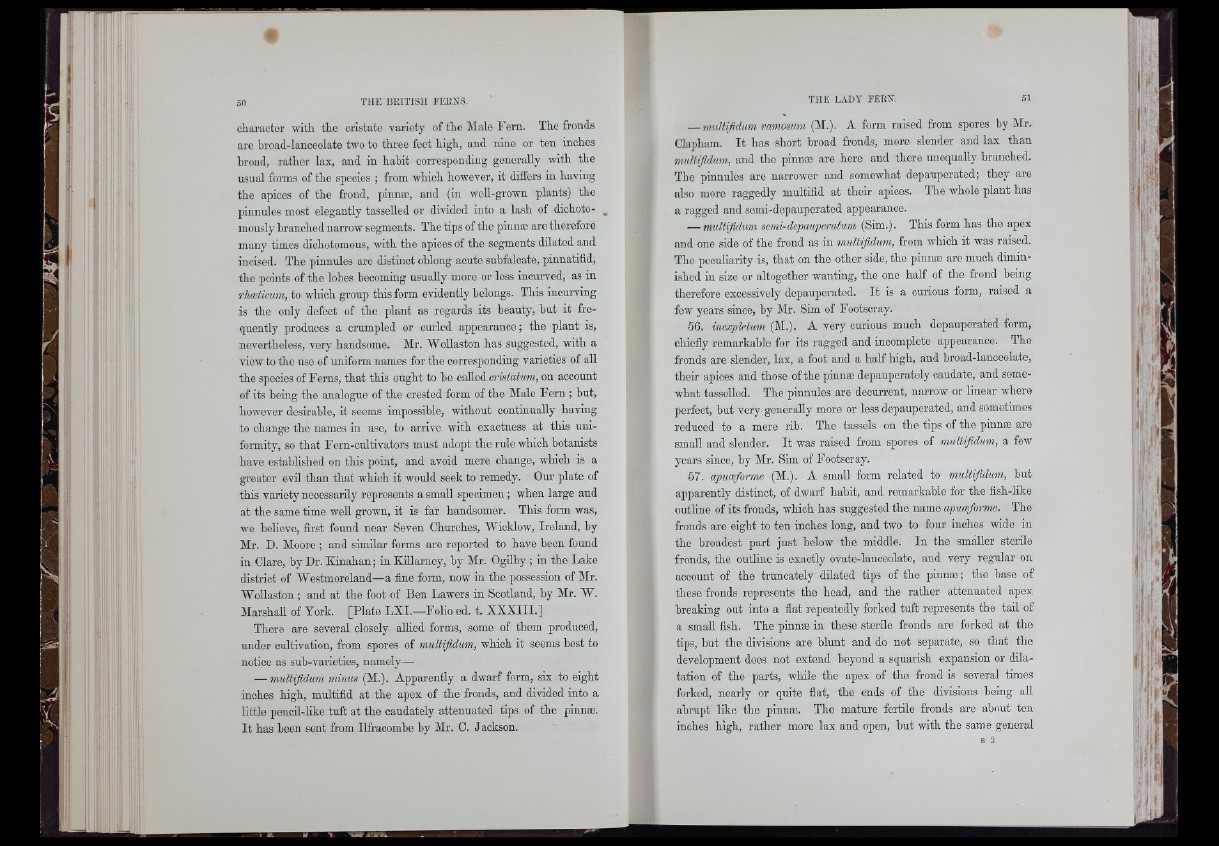
50 THE BEITISH EEEKS. THE LADY FERN. 51
character with the cristate variety of the Male Fern. The fronds
are broad-lanceolate two to three feet high, and nine or ten inches
broad, ratber lax, and in habit corresponding generally witb the
usual forms of the species ; from which however, it differs in having
the apices of the frond, pinnæ, and (in well-grown plants) the
pinnules most elegantly tasselled or divided into a lash of diohoto- ,
mously branched narrow segments. The tips of the pinnæ are therefore
many times dichotomous, with the apices of the segments dilated and
incised. The pinnules are distmot oblong acute subfalcate, pinnatifid,
the points of the lobes hecoming usually more or less incurved, as in
rhæticum, to which group this form evidently belongs. This inourviug
is the only defect of the plant as regards its beauty, but it frequently
produces a crumpled or curled appearance ; tbe plant is,
nevertheless, very handsome. Mr. Wollaston has suggested, with a
view to the use of uniform names for the corresponding varieties of all
the species of Ferns, that this ought to be called cristatum, on account
of its being the analogue of the crested form of the Male Fern ; hut,
however desirable, it seems impossible, without continually having
to change the names in use, to arrive with exactness at this uniformity,
so that Forn-cultivators must adopt the rule which botanists
have established on this point, and avoid mere change, which is a
greater evil than that which it would seek to remedy. Our plate of
this variety necessarily represents a small specimen ; when large and
at the same time well grown, it is far handsomer. This form was,
we believe, first found near Seven Churches, Wicklow, Ireland, by
Mr. D. Moore ; and similar forms are reported to have been found
in Clare, by Dr. Kinahan ; in Killarney, by Mr. Ogilby ; in tbe Lake
district of Westmoreland—a fine form, now in the possession of Mr.
Wollaston ; and at the foot of Ben Lawers in Scotland, by Mr. W.
Marshall of York. [Plate LXI.—Folio ed. t. XXXIII.]
There are several closely allied forms, some of them produced,
under cultivation, from spores of nmltifidim, which it seems best to
notice as sub-varieties, namely—
— multifidum minus (M.). Apparently a dwarf form, six to eight
inches high, multifid at the apex of the fronds, aud divided into a
little penoü-Ilke tuft at the caudately attenuated tips of the pinnæ.
It has been sent from Ilfracombe by Mr. C. Jaekson.
— muttifidum ramosum (M.). A form raised from spores by Mr.
Clapham. It has short broad fronds, more slender and lax than
multifidum, and the pinnæ are here and there unequally branched.
The pinnules are narrower and somewhat depauperated; they are
also more raggedly multifid at their apices. The whole plant has
a ragged and semi-depauperated appearance.
— multifidum semi-depauperatum (Sim.). This form has the apex
and one side of the frond as in multifidum, from which it was raised.
The peculiarity is, that on the other side, the pinnæ are much diminished
in size or altogether wanting, the one half of the frond being
therefore excessively depauperated. It is a curious form, raised a
few years since, by IMr. Sim of Footscray.
56. inexplctum (M.). A very curious much depauperated form,
chiefly remarkable for its ragged and incomplete appearance. The
fronds are slender, lax, a foot and a half high, and broad-lanceolate,
their apices and those of the pinnæ depauperately caudate, and somewhat
tasselled. The pinnules are decurrent, narrow or linear whero
perfect, but very generally more or less depauperated, and sometimes
reduced to a mere rib. The tassels on the tips of the pinnæ arc
small and slender. It was raised from spores of multifidum, a few
years since, by Mr. Sim of Footscray.
57. apuæforme (M.). A small form related to multifidum, but
apparently distinct, of dwarf habit, and remarkable for the fish-like
outline of its fronds, which has suggested the name apuæforme. The
fronds are eight to ten inches long, and two to four inches wide in
the broadest part just below tbe middle. In the smaller sterile
fronds, the outline is exactly ovate-lanceolate, and very regular on
account of the truncately dilated tips of the pinnæ ; the base of
these fronds represents the head, and the rather attenuated apex
breaking out into a flat repeatedly forked tuft represents the tail of
a small fish. The pinnæ iu these sterile fronds are forked at the
tips, but the divisions are blunt and do not separate, so that tbe
development does not extend beyond a squarish expansion or dilatation
of tbe parts, while the apex of the frond is several times
forked, nearly or quite flat, the ends of the divisions being all
abrupt like the pinnæ. The mature fertile fronds are about ten
inches high, rather more lax and open, hut with the same general
I'J
; 'i|
: ‘ir ' lI
' t ' i
' '
I 'I
I;'
( I " ' I
f| I;*
«ii'l
i ’ l
i :
M I